Long-Term Stability of Ferroelectret Energy Harvesters
Abstract
:1. Introduction
2. Methods
2.1. Mathematical Model
2.2. Harvester Fabrication
2.3. Experimental Procedure
2.3.1. Film Characterization
2.3.2. Harvester Characterization
3. RESULTS
3.1. Characterization of Cellular Polypropylene
3.2. Harvester Characterization
3.3. Model Validation
4. Discussion and Conclusions
Author Contributions
Funding
Conflicts of Interest
References
- Erturk, A.; Inman, D.J. Piezoeletric Energy Harvesting; John Wiley & Sons: Hoboken, NJ, USA, 2011; p. 392. [Google Scholar] [CrossRef]
- Thambi, N.; Sastry, A.M. Powering MEMS portable devices—A review of non-regenerative and regenerative power supply systems with special emphasis on piezoelectric energy. Smart Mater. Struct. 2008, 17, 043001. [Google Scholar] [CrossRef] [Green Version]
- Beeby, S.P.; Tudor, M.J.; White, N.M. Energy harvesting vibration sources for microsystems applications. Meas. Sci. Technol. 2006, 17, R175. [Google Scholar] [CrossRef]
- Caliò, R.; Rongala, U.B.; Camboni, D.; Milazzo, M.; Stefanini, C.; de Petris, G.; Oddo, M.C. Piezoelectric energy harvesting solutions. Sensors 2014, 14, 4755–4790. [Google Scholar] [CrossRef] [PubMed] [Green Version]
- Anton, S.R.; Farinholt, K.M.; Erturk, A. Piezoelectret foam-based vibration energy harvesting. J. Intell. Mater. Syst. Struct. 2014, 25, 1681–1692. [Google Scholar] [CrossRef]
- Pondrom, P.; Hillenbrand, J.; Sessler, G.M.; Bös, J.; Melz, T. Energy Harvesting with Single-layer and Stacked Piezoelectret Films. IEEE Trans. Dielectr. Electr. Insul. 2015, 22, 1470–1476. [Google Scholar] [CrossRef]
- Bauer, S.; Gerhard-Multhaupt, R.; Sessler, G.M. Ferroelectrets: Soft Electroactive. Phys. Today 2004, 57, 37–43. [Google Scholar] [CrossRef]
- Tajitsu, Y. Piezoelectret Sensor Made From an Electro-spun Fluoropolymer and Its Use in a Wristband for Detecting Heart-beat Signals. IEEE Trans. Dielectr. Electr. Insul. 2015, 22, 1355–1359. [Google Scholar] [CrossRef]
- Niu, P.; Chapman, P.; Riemer, R.; Zhang, X. Evaluation of motions and actuation methods for biomechanical energy harvesting. In Proceedings of the 2004 IEEE 35th Annual Power Electronics Specialists Conference (IEEE Cat. No.04CH37551), Aachen, Germany, 20–25 June 2004; Volume 3, pp. 2100–2106. [Google Scholar] [CrossRef]
- Nie, J.; Ji, M.; Chu, Y.; Meng, X.; Wang, Y.; Zhong, J. Nano Energy Human pulses reveal health conditions by a piezoelectret sensor via the approximate entropy analysis. Nano Energy 2019, 58, 528–535. [Google Scholar] [CrossRef]
- Paajanen, M.; Lekkala, J.; Kirjavainen, K. ElectroMechanical Film (EMFi)—A new multipurpose electret material. Sens. Actuators 2000, 84, 95–102. [Google Scholar] [CrossRef]
- Mellinger, A.; Wegener, M.; Wirges, W.; Mallepally, R.R.; Gerhard-Multhaupt, R. Thermal and Temporal Stability of Ferroelectret Films Made from Cellular Polypropylene/Air Composites; Taylor & Francis: Abingdon, UK, 2006; pp. 189–199. [Google Scholar] [CrossRef]
- Wan, Y.; Xie, L.; Zhang, X.; Zhong, Z. Time dependence of piezoelectric polypropylene film coefficient of cellular ferroelectret. Appl. Phys. Lett. 2016, 98, 122902. [Google Scholar] [CrossRef]
- Qu, S.; Yu, Y. Electromechanical coupling properties and stability analysis of ferroelectrets. J. Appl. Phys. 2011, 110. [Google Scholar] [CrossRef]
- Ray, C.A.; Anton, S.R. Multilayer piezoelectret foam stack for vibration energy harvesting. J. Intell. Mater. Syst. Struct. 2017, 28, 408–420. [Google Scholar] [CrossRef]
- Sessler, G.M. Stacked and folded piezoelectrets for vibration-based energy harvesting. Phase Transit. 2016, 89, 667–677. [Google Scholar] [CrossRef]
- Luo, Z.; Zhu, D.; Beeby, S.P. Multilayer ferroelectret-based energy harvesting insole. J. Phys. Conf. Ser. 2015, 660, 1–6. [Google Scholar] [CrossRef] [Green Version]
- Luo, Z.; Zhu, D.; Beeby, S. An electromechanical model of ferroelectret for energy harvesting. Smart Mater. Struct. 2016, 25. [Google Scholar] [CrossRef] [Green Version]
- Pondrom, P.; Hillenbrand, J.; Sessler, G.M.; Bös, J.; Melz, T. Vibration-based energy harvesting with stacked piezoelectrets. Appl. Phys. Lett. 2014, 104, 172901. [Google Scholar] [CrossRef]
- Fialka, J.; Beneš, P. Comparison of Methods of Piezoelectric Coefficient Measurement. In Proceedings of the 2012 IEEE International Instrumentation and Measurement Technology Conference Proceedings, Graz, Austria, 13–16 May 2012. [Google Scholar]
- Polytec. MSV-400 Microscope Scanning Vibrometer. 2019. Available online: http://www.vibrometry.co.kr/MSV-300.pdf (accessed on 9 December 2019).
- Research, V. VibrationVIEW Manual; Vibration Research Corporation: Jenison, MI, USA, 2019. [Google Scholar]
- Ewins, D.J. Modal Testing: Theory, Practice, and Application; Research Studies Press: Boston, MA, USA, 2000. [Google Scholar]
- Kong, N.; Ha, D.S.; Erturk, A.; Inman, D.J. Resistive Impedance Matching Circuit for Piezoelectric Energy Harvesting. J. Intell. Mater. Syst. Struct. 2010, 21, 1293–1302. [Google Scholar] [CrossRef]


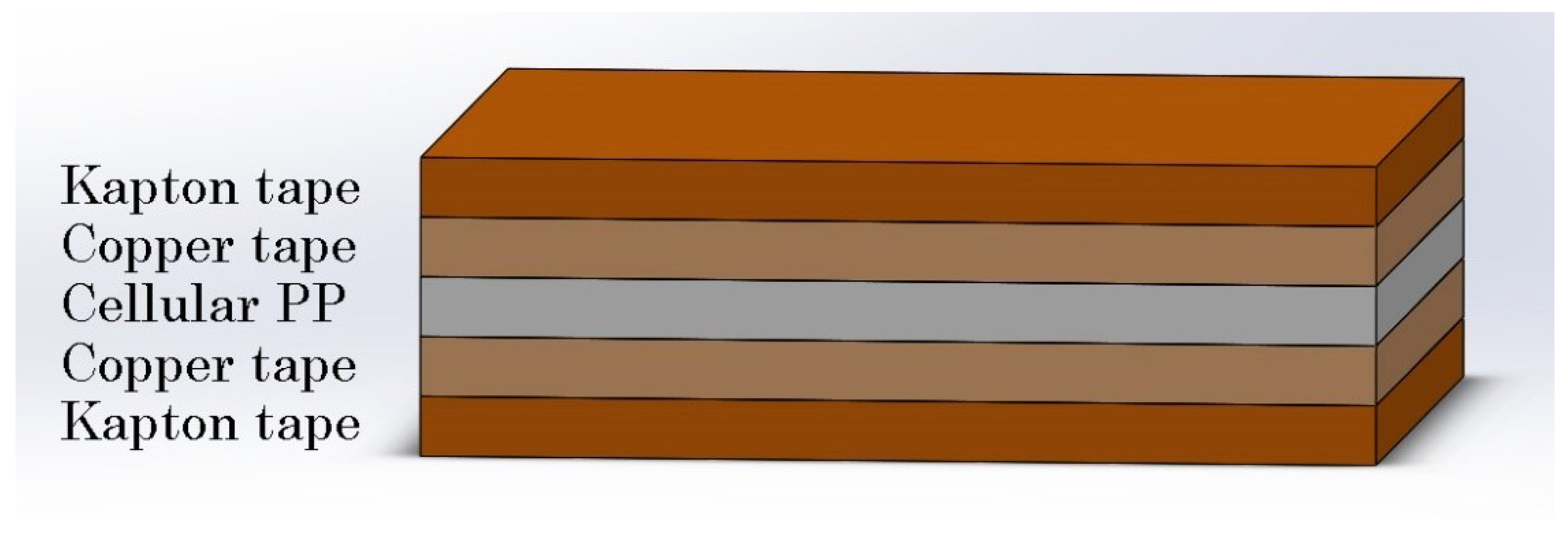
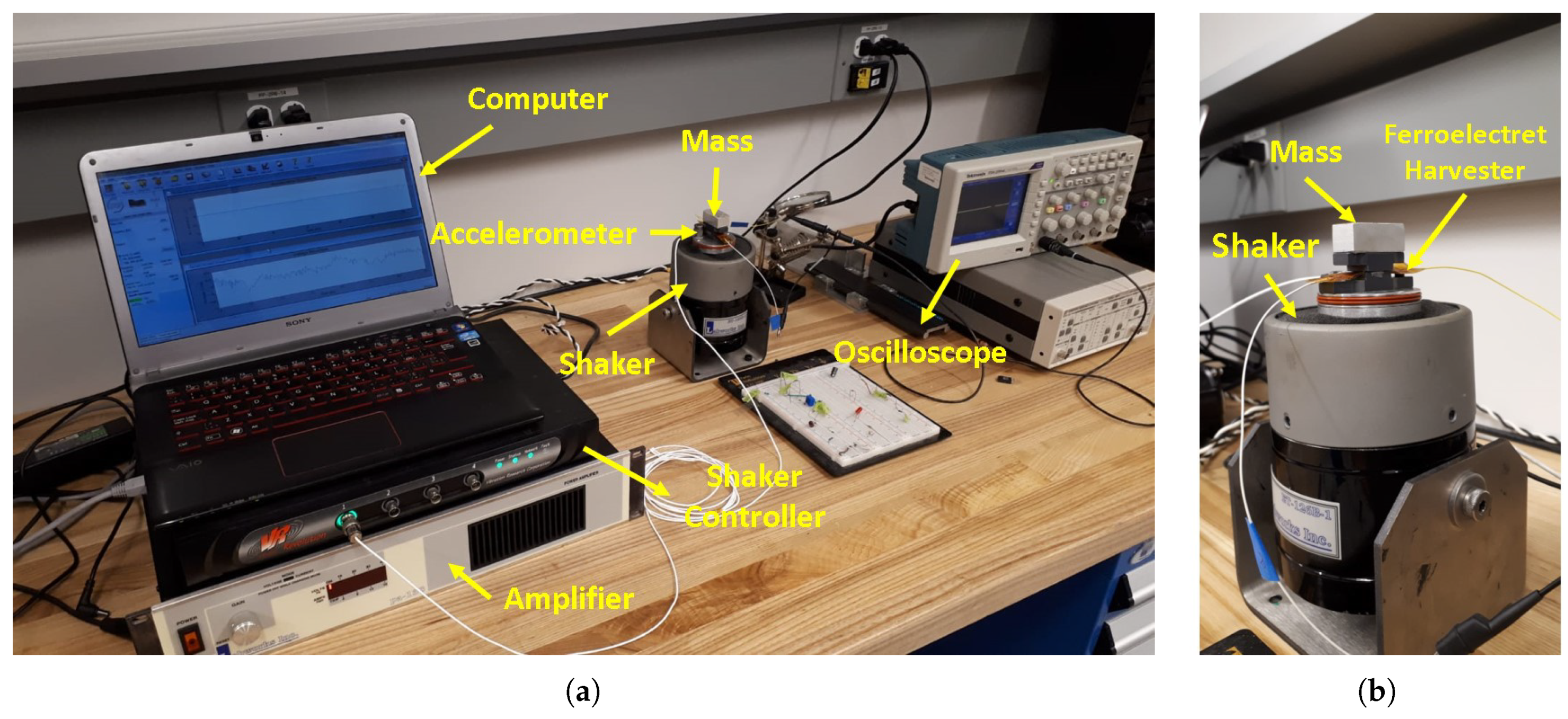
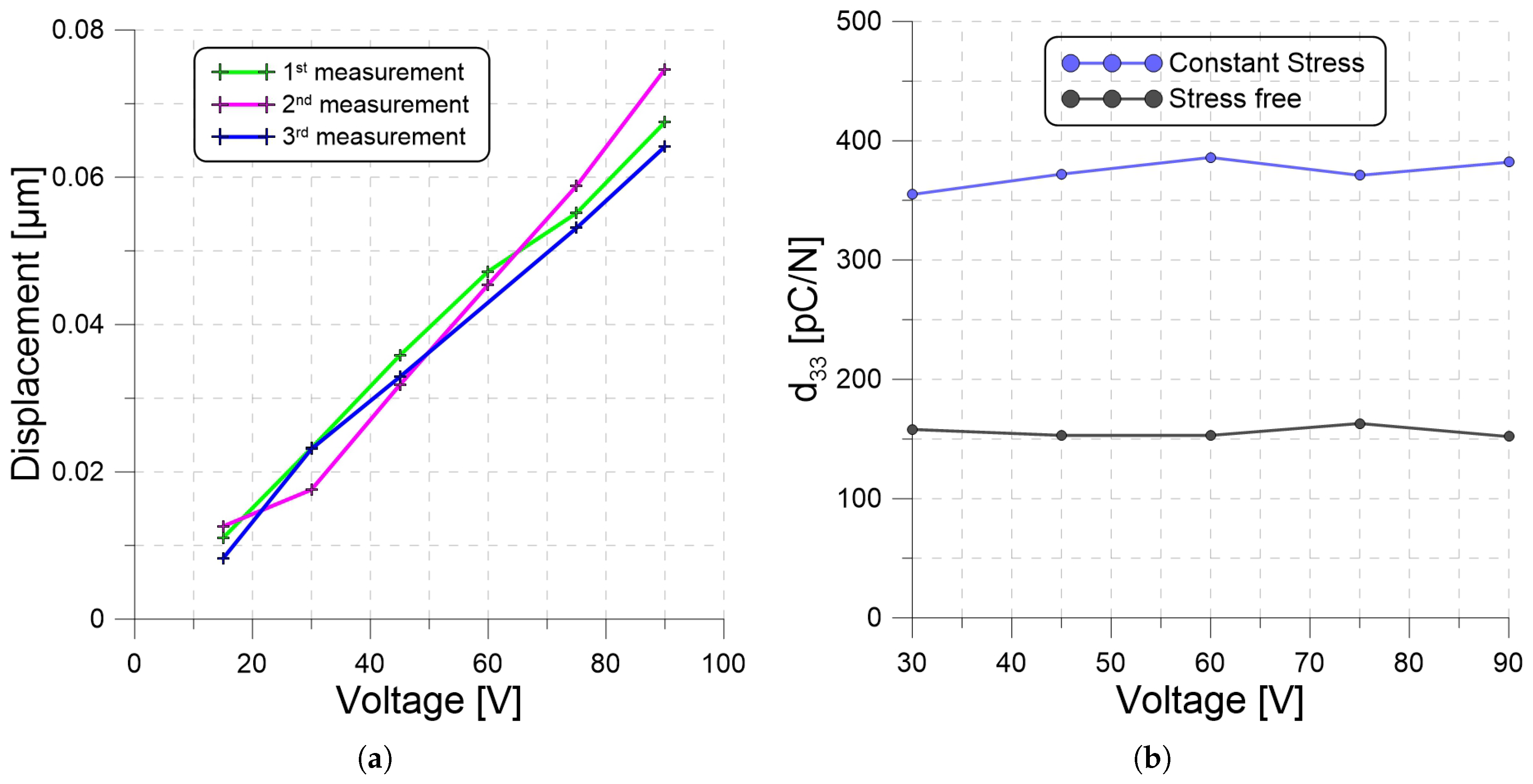
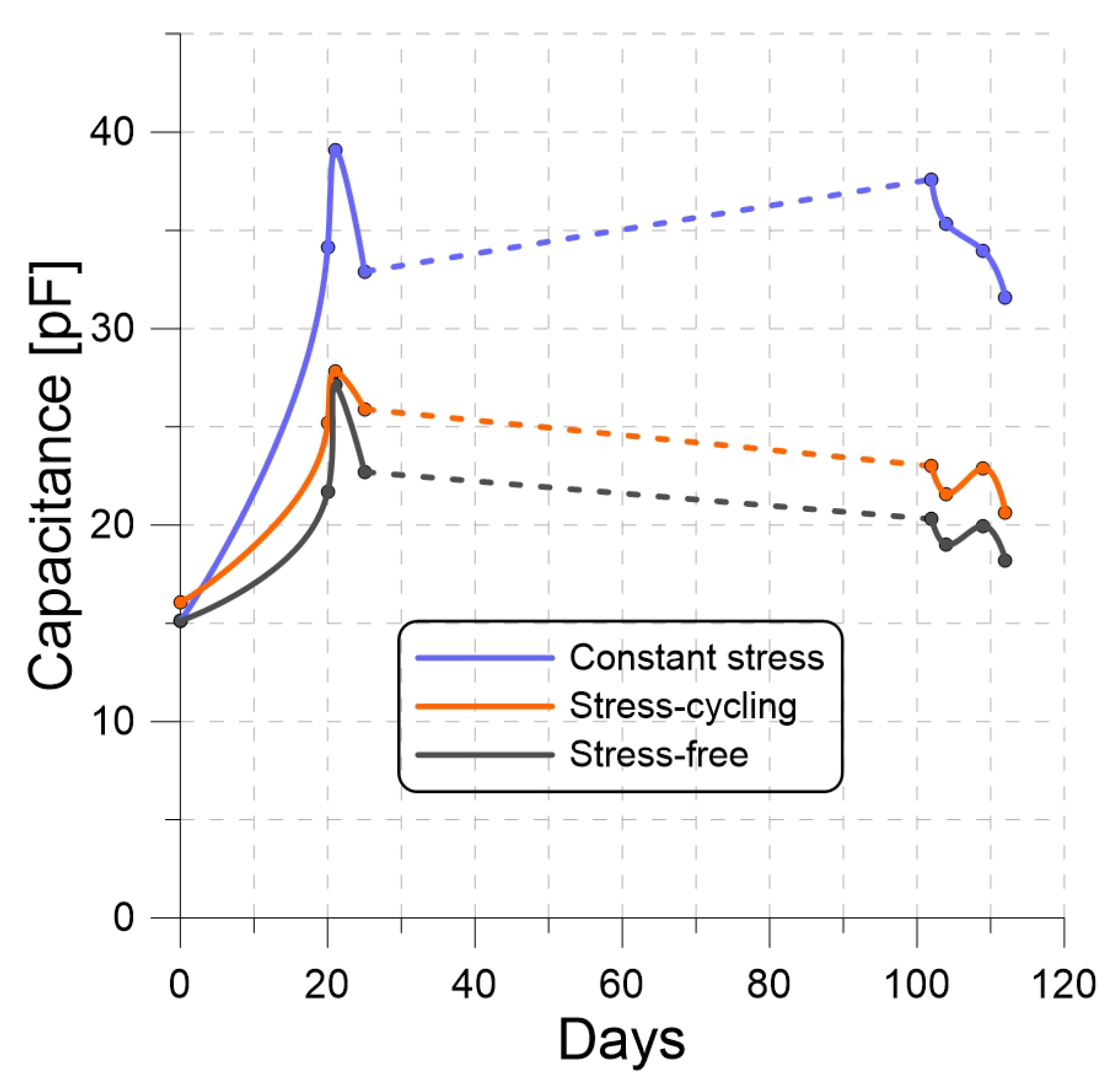
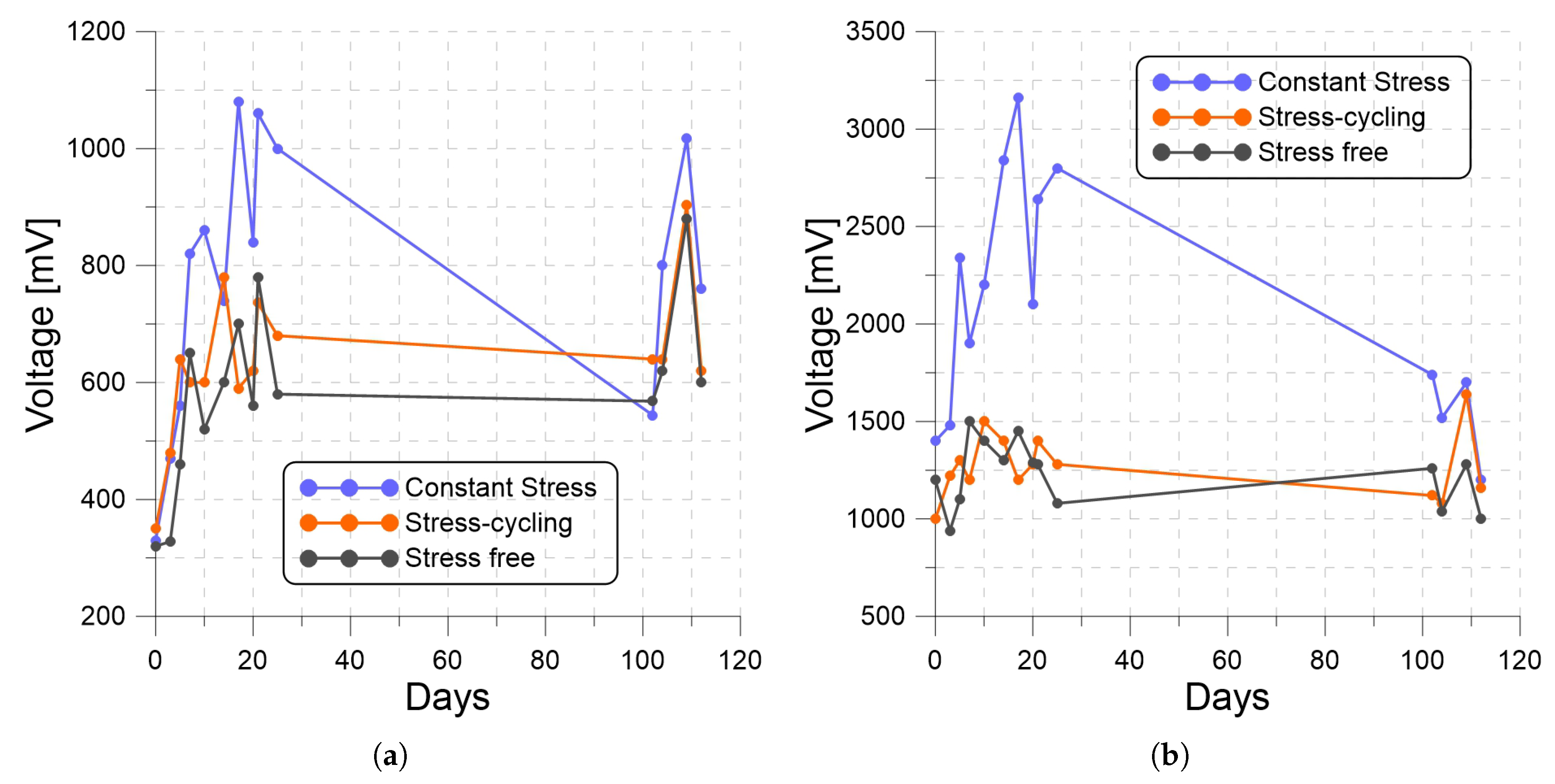


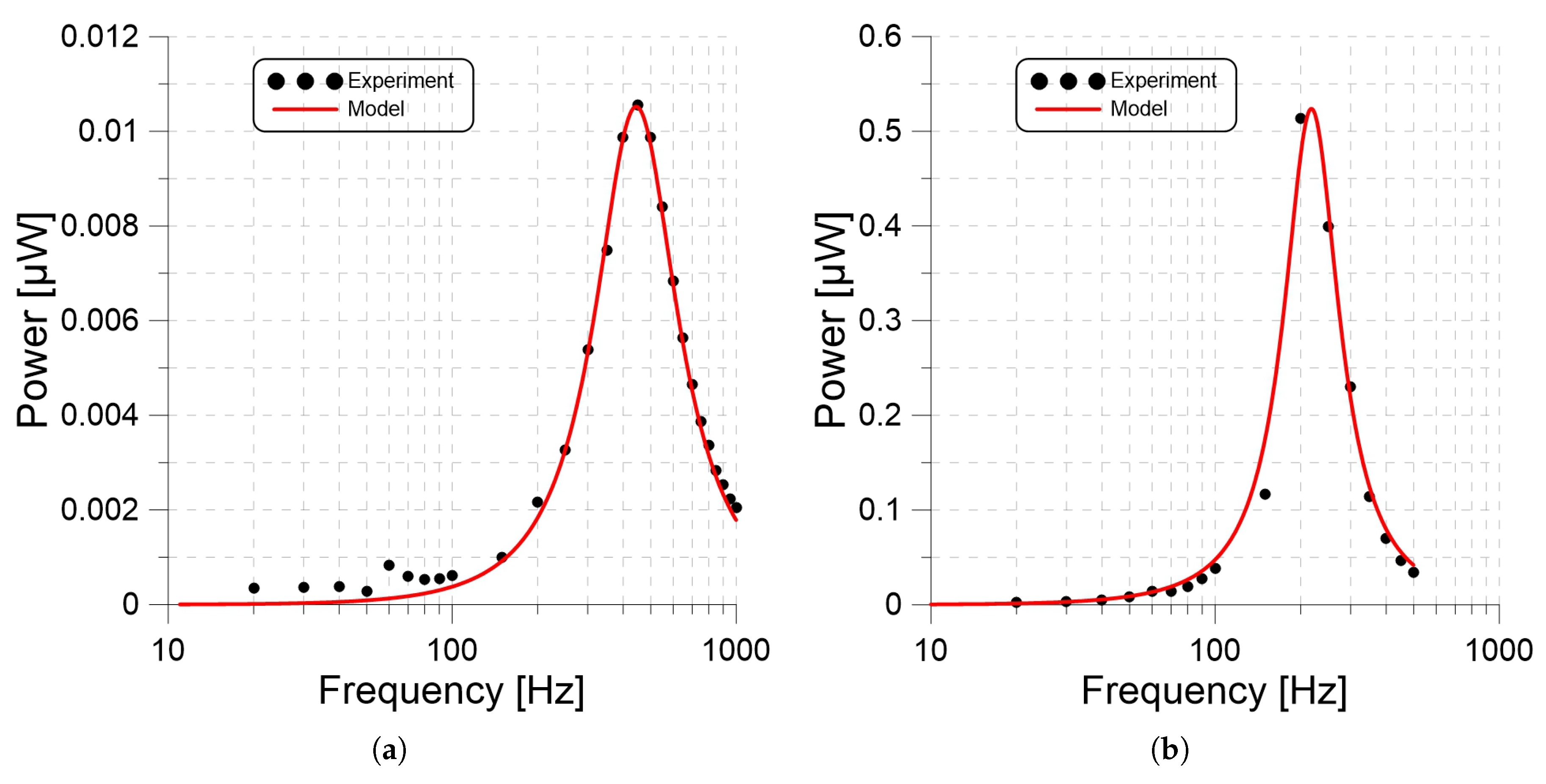
© 2019 by the authors. Licensee MDPI, Basel, Switzerland. This article is an open access article distributed under the terms and conditions of the Creative Commons Attribution (CC BY) license (http://creativecommons.org/licenses/by/4.0/).
Share and Cite
Kayaharman, M.; Das, T.; Seviora, G.; Saritas, R.; Abdel-Rahman, E.; Yavuz, M. Long-Term Stability of Ferroelectret Energy Harvesters. Materials 2020, 13, 42. https://doi.org/10.3390/ma13010042
Kayaharman M, Das T, Seviora G, Saritas R, Abdel-Rahman E, Yavuz M. Long-Term Stability of Ferroelectret Energy Harvesters. Materials. 2020; 13(1):42. https://doi.org/10.3390/ma13010042
Chicago/Turabian StyleKayaharman, Muhammed, Taylan Das, Gregory Seviora, Resul Saritas, Eihab Abdel-Rahman, and Mustafa Yavuz. 2020. "Long-Term Stability of Ferroelectret Energy Harvesters" Materials 13, no. 1: 42. https://doi.org/10.3390/ma13010042





